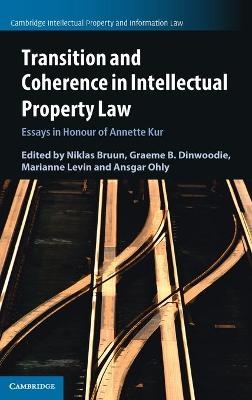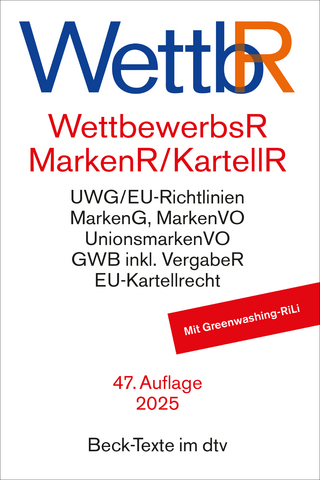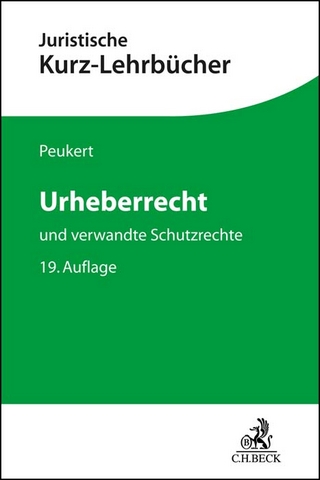
Transition and Coherence in Intellectual Property Law
Cambridge University Press (Verlag)
978-1-108-48460-2 (ISBN)
The nature and content of intellectual property (IP) law, which is heavily contingent on the state of technology and on social and market developments, has always been subject to ongoing transitions. How those transitions are effected and the shape they take is crucial to the ability of IP to achieve its stated goals and provide the necessary climate for investment in creativity, innovation and brand differentiation. Yet the need for change can run headlong into a desire for coherence. A search for coherence tests the limits of the concept of “intellectual property,” is imperiled by overlaps between different IP regimes, and calls for a unifying normative theme. This volume assembles contributors from across IP and the globe to explore these questions, including whether coherence is desirable. It should be read by anyone interested in understanding the conceptual underpinnings of one of the most important and dynamic areas of the law.
Niklas Bruun is Professor emeritus, Hanken School of Economics Helsinki. He served as the Director of the IPR University Center in Helsinki from 2000-2018. He has been the leading scholar in IP-law in Finland for many years and is the author of numerous books and articles in the field, including Intellectual Property Law of Finland. Professor Bruun has also been the chair of several committees for law revisions of IP in Finland. Together with Professor Nari Lee, he led a research project on innovation and IP enforcement in China that brought together researchers from across Europe and China. Graeme Dinwoodie is the Global Professor of Intellectual Property Law at Chicago-Kent College of Law. He remains a visiting Professor at the University of Oxford, where he held the IP Chair for nine years. His previous visiting appointments include serving as the Yong Shook Lin Visiting Professor of Intellectual Property Law at the National University of Singapore, and Global Professor of Law at New York University School of Law. Professor Dinwoodie was a John F. Kennedy Scholar at Harvard Law School and was elected to the American Law Institute in 2003. He is the co-author of A Neofederalist Vision of TRIPS: The Resilience of the International Intellectual Property Regime and five casebooks. Marianne Levin is Professor emerita, Department of Law, Stockholm University. Since 1995, she has served as the Chair of the Swedish Association for the Protection of Intellectual Property Rights. Professor Levin was the head of the Press and PR department of the EPO from 1986-1988, and was one of the four people involved in the 1990 draft for an EU Design protection. She served as the Director of the Institute of Intellectual Property and Market Law, and founded the Master's Program in European Intellectual Property Law at Stockholm University. She holds an honorary doctorate from the Swedish School of Economics, Helsinki. Ansgar Ohly holds the Chair of Private Law, Intellectual Property and Competition Law at the Ludwig Maximilian University of Munich. He is also a Visiting Professor at the University of Oxford and a Visiting Senior Member of St Peter's College Oxford. He has published widely on all areas of intellectual property law and the law of unfair competition law, with a special emphasis on European developments and the comparison of civil law and common law systems. He is the co-editor of GRUR, the leading German intellectual property journal, and of the commentary on German copyright law founded by G. Schricker.
Preface; Greetings to Annette Kur from the second floor; Annette Kur: toward understanding; Part I. Transition; Section 1. Forms and institutions: 1. Transitional provisions in intellectual property legislation; 2. Judicial creativity and transitions in EU IP law; 3. Before and after designers guild: another look at appellate deference in New Zealand's copyright law; 4. EU design law: transitioning towards coherence? 15 years of national case law; 5. Copyright and the CJEU – some structural deficits as seen from a german perspective; Section 2. International commitments and constraints: 6. Global intellectual property: transition and coherence through rules of interpretation; 7. Article 20 of the TRIPS agreement: up in smoke?; 8. Implementing international obligations at the national level; 9. Multiple and overlapping transitions in IP; 10. Transition and continuity in the private international law of intellectual property; 11. From nintendo wii to perfumes, driving a BMW car: a tale of transition to the wrong kind of coherence; Section 3. New agents and the challenge of new technologies: 12. Transition through automation; 13. Eye, robot: artificial intelligence and trade mark registers; 14. Patent protection of inventions involving artificial intelligence; 15. Automated profiling in new media and entertainment markets: what to protect, and how?; Part II. Coherence; Section 4. Intellectual “property” and its limits: 16. The (lack of) coherence of data ownership with the intellectual property system; 17. The threefold fictitiousness of intellectual property; 18. An intellectual property structural engineer extraordinaire and her lifelong quest for coherence; 19. Open yet secret: trading of tangible goods and trade secrets; 20. From smorgasbord to new Nordic cuisine: EU-harmonization of trade secrets protection in the Nordic countries; 21. Trade mark rights and parallel imports vis-à-vis the never-ending evolution of the behavior of firms: transition and coherence put to a test; 22. Legal concept of “exhaustion”: exhausted?; 23. Building coherence in technological transitions: putting exploitation at the core of intellectual property; 24. 'Accessory exhaustion' – and use of a work as a work; Section 5. IP overlaps: 25. Intellectual property in transition: the several sides of overlapping copyright and trademark protection; 26. Cultural heritage and the public domain: what the us's myriad and mayo can teach Oslo's angry boy; 27. Public order in the light of aesthetic theory – the copyright/trademark interface after vigeland; 28. Separability as channeling: a cautionary tale; 29. Novelty, idea or new meaning as criteria for copyright protection?: transitions in swedish design law; 30. Examining functionality; 31. Substantial value and the concept of shapes; 32. Copyright and patents on software: the UPC's answer to an old problem of intellectual property overlaps; 33. Chopping off Hydra's heads: spare parts in EU design and trade mark law; Section 6. (Un-) fairness; 34. Geographical indications as intellectual property rights: beyond transition and coherence?; 35. Presence or absence of coherence in trade identity protection in the European Union; 36. Virtue ethics and private law – a sketch; 37. Closing the gap: how EU law constrains national rules against imitation?; 38. European Union law and slavish imitation – an 'update' in honour of Annette Kur; 39. The german misappropriation origins of trademark antidilution doctrine: a translation of the 1924 odol opinion of the Elberfeld Landgericht; 40. The relationship between the unfair competition regime and IP law; 41. Comparative advertising: does trade mark law over- or under- protect the average consumer? A couple of recent examples of Asian jurisdictions going their own way; Conclusion: 42. Transition and coherence in intellectual property law.
| Erscheinungsdatum | 15.01.2021 |
|---|---|
| Reihe/Serie | Cambridge Intellectual Property and Information Law |
| Zusatzinfo | Worked examples or Exercises |
| Verlagsort | Cambridge |
| Sprache | englisch |
| Maße | 160 x 240 mm |
| Gewicht | 900 g |
| Themenwelt | Recht / Steuern ► Allgemeines / Lexika |
| Recht / Steuern ► EU / Internationales Recht | |
| Recht / Steuern ► Wirtschaftsrecht ► Urheberrecht | |
| ISBN-10 | 1-108-48460-3 / 1108484603 |
| ISBN-13 | 978-1-108-48460-2 / 9781108484602 |
| Zustand | Neuware |
| Haben Sie eine Frage zum Produkt? |
aus dem Bereich


